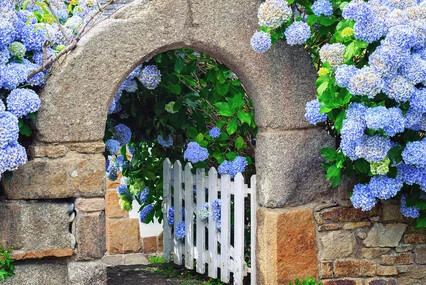If you catch this process early, you can actually reverse it.

Nothing diminishes the appearance of hydrangeas faster than browning blooms, and if you're beginning to find an increasing number of brown flowers, professional gardener Melinda Myers says you might be doing something wrong. "Premature brown blooms are a sign that you need to adjust your plant care," she says. "When plants experience stress or damage, they begin to wilt and the flowers turn brown sooner than they should."
And while Myers says that it's normal for certain hydrangea blooms to turn brown as they age, she says if newly-planted ones start losing their color, there's a chance they're not receiving enough moisture. "Drought stress can cause flowers to turn brown earlier than normal, as can over-fertilization or excessive aluminum sulfate in the soil," she explains. So, what to do when faced with a garden filled with browning hydrangea blooms? We asked Myers for her advice and this is what she had to say.
Aim for partial sun.
High temperatures can deprive plants of moisture, which is why Myers recommends planting (or transplanting) your hydrangeas in a site with partial sun and shade to help prevent browning. "Growing your plants in the preferred site will help you grow healthy plants and give you the best opportunity to extend flowering," she says. "A bit of afternoon shade is essential for 'Annabelle' and bigleaf hydrangeas, especially in regions with very hot summers."
Watch your watering schedule.
Both over and under-watering your hydrangeas can cause them to weaken and brown, so Myers says it's crucial be precise about irrigation. "Water established plants thoroughly but less frequently to encourage deep roots that are more drought tolerant," she says. For newly-planted hydrangeas, she recommends watering them up to three times a week to keep the soil moist and the blooms from crisping.
Mulch before you fertilize.
If you're over-fertilizing your garden soil, Myers says you'll wind up with worse problems than browning hydrangea blooms. "Too much fertilizer, especially ones that are high in nitrogen and aluminum sulfate, can weaken and eventually kill your plant," she says. Before you reach for the fertilizer, she recommends adding mulch to the soil to conserve moisture and keep the roots of your hydrangeas cool throughout the summer.
Test your soil.
If you aren't testing the pH levels of your soil regularly, Myers says it's time to start. "Soil that is either too acidic or too alkaline can quickly cause your hydrangea flowers to turn brown, so it's essential to have your soil tested to determine the right kind of fertilizer needed," she explains. If you prefer to test your soil without the help of a pro, pick up a pH meter or soil test kit and handle it yourself.
Know when they're beyond repair.
If you catch and treat your hydrangeas when their blooms first start turning brown, Myers says there's a good chance you'll be able to turn them around (as long as it's not due to weather damage). "However, once they turn fully brown, there's not much you can do," she says. "If it's a repeat bloomer, adjust care accordingly and try to delay browning on the second flush of flowers."